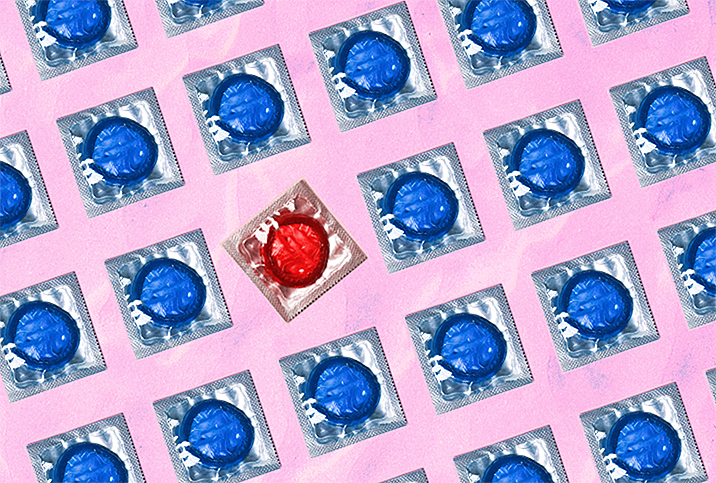Obsessive-Compulsive Disorder and Its Various Forms

Obsessive-compulsive disorder (OCD) is said to affect about 2.3 percent of U.S. adults in their lifetime. However, the range of symptoms—and the degree to which they impair your life—can vary significantly, with data suggesting 50.6 percent of adults with OCD have serious impairment, 34.8 percent experience moderate impairment and 14.6 percent have mild impairment, according to the National Institute of Mental Health.
Sexuality and OCD is an under-recognized topic, but research suggests there may be links between obsessive-compulsive disorder and sexual dysfunction. Evidence indicates that OCD can be associated with dissatisfaction with a partner and overall disgust with any sexual activity, a fear of having sex, a lower libido and overall worse sexual functioning. Hypersexuality can also be a symptom of OCD.
What is OCD?
"OCD, obsessive-compulsive disorder, is a disorder that impacts thoughts and behaviors," said Rosalind Pistilli, L.C.S.W., a therapist in Colorado and the executive director of Open Arms Transition Center. "Usually, these thoughts are intrusive—unwanted—or obsessive in nature. Most people who experience OCD describe the thoughts as disruptive or disturbing to them."
Anna Jackson, a psychotherapist based in London who specializes in cognitive behavioral therapy (CBT) and treating OCD, described the nature of OCD-related intrusive thoughts in more detail.
"The individual is plagued by irrational, sticky thoughts that they just can't shift, and it can manifest in a vast variety of ways," Jackson said. "The underlying theme, however, is the same. OCD only latches onto things that trigger or concern the individual; these are, of course, different for different people."
In other words, an individual with OCD doesn't just incur random thoughts or pleasant thoughts or ones they can control or let go. Rather, the intrusive thoughts characteristic of OCD are concerning, unwanted, problematic, disturbing or disruptive to the individual's life.
Coupled with the intrusive thoughts can be the presence of obsessive or compulsive compensatory or resultant behaviors.
"To neutralize these intrusive thoughts, the individual often feels compelled to carry out certain behaviors or compulsions," Jackson said. "The individual feels a huge sense of personal responsibility. There is also commonly the underlying belief, 'I don't trust myself' and 'I'm not safe.' OCD is commonly known as the 'doubting disorder.' The doubt fuels more doubt."
William Anixter, M.D., a psychiatrist at CooperRiis Healing Community in North Carolina, provided further insight into the nature of obsessions and compulsions characteristic of OCD.
"One part of the illness or the obsessions…are recurrent intrusive thoughts or images that come into a person's mind and are disturbing and anxiety-producing, such as 'I may have touched something that is dirty and contaminated' or 'I may have left my windows or doors unlocked and my house is vulnerable,'" Anixter said. "And then the second part are the compulsions, which are acts that are designed to reduce anxiety. So in the first example, if you have a fear that you've touched something that is dirty or contaminated, that's the recurrent thought, and the compulsion may be to wash, and to wash excessively."
Who is most likely to get OCD?
Pistilli said OCD appears more in women than in men, but there is a lot about OCD that isn't understood, such as what causes OCD and who is most at risk.
"There are a lot of theories on genetics or trauma, but none that have been proven to be a definitive answer of what causes OCD to develop in one person versus another," Pistilli said.
"OCD is a common disorder that affects people of all ages around the world," said Faisal Tai, M.D., a board-certified psychiatrist and the CEO of mental healthcare provider, PsychPlus. "Most cases of OCD occur by the age of 19, although boys tend to experience OCD earlier than girls."
Jackson provided additional insight into the appearance of OCD and potential risk factors.
"OCD often begins either in childhood or after a particularly stressful event in a person's life; the initial theme may change with time. Individuals with underlying anxiety can be prone to OCD as well as those who struggle to manage stress," she explained, adding that OCD can be hereditary but isn't always.
"What is key to note is that people with OCD have less gray matter in the region of the brain," Jackson added. "This gray matter is important in suppressing responses and habits. This shows us that certain individuals are more genetically inclined to develop the condition than others."
There is no specific test for OCD. Rather, OCD is usually diagnosed by an experienced mental health professional based on a discussion of symptoms.
"Qualified mental health providers use criteria contained in the Diagnostic and Statistical Manual of Mental Disorders, Fifth Edition (DSM-5) to help diagnose OCD," Tai said. "Medical professionals arrive at a diagnosis by asking questions and observing behaviors of patients under treatment."
The various types of OCD
Although many people think OCD is a single type of mental health disorder, much in the way of anxiety disorders, there are actually different types of OCD. Although all types of OCD share similar characteristics, such as obsessive thoughts and compulsive behaviors, the different types of OCD each have unique characteristics or differing patterns of presentation, severity and symptoms.
Jackson explained that "classic" OCD involves a series of obsessive thoughts carried out by a compulsion or compulsions to neutralize the intrusive thought or thoughts.
Pistilli said some of the most common types of OCD include:
- Checking
- Contamination
- Harm
- Hoarding
- Symmetry
"It is very common to have multiple different types of OCD, such as checking and harm, which results in obsessing over checking to be sure that the stove is off due to fear of harm," she said. "Someone with symmetry OCD may also be concerned with contamination, etcetera. It is important to note that compulsion does not have to exist for OCD to become an issue. Obsessive and intrusive thoughts can exist without compulsion."
Given the symptoms of OCD, it's not surprising that having OCD can cause a deep and lasting impact on the quality of life for the individual, even in cases where OCD may be mild.
"OCD can be mild and it can be quite severe, leading to loss of pleasure, impact on occupational functioning, a strain on relationships, etcetera," Pistilli said. "Some of the contamination OCD symptoms can lead to agoraphobia due to being afraid to be exposed to threats of contamination."
Jackson noted that OCD symptoms can become severe.
"I have seen cases where OCD has become so bad that the individual refuses to leave their home," she said. "Or it takes the individual two hours to leave their apartment because they must check every appliance and switch is off, perhaps 20 times or until 'it feels right.'"
Anixter said OCD tendencies are fairly common and often do not reach pathological levels, as in they don't cross a threshold that becomes problematic for the individual.
"So many people have a little bit of OCD, and it's not always a pathological or a destructive tendency in small amounts," he noted. "[However], someone with OCD tends to repeat things over and over, and in this severe form, this can become extremely time-consuming and problematic."
When not well-managed, the symptoms of OCD can affect a person's overall well-being, quality of life and ability to function "normally" in society.


















